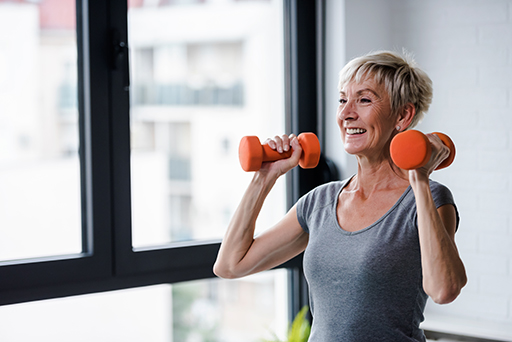6 What kind of exercise should be done?
There is plenty of choice with regard to exercise, but the following 4 types of exercise are very important to mitigate the effects of the menopause.
Aerobic training
Cardiorespiratory exercise is important at all times of life, as it benefits and protects the health of the heart, lungs and circulatory system, as well as supporting good mental health and helping people to keep their weight stable. In menopause, it is important to do some aerobic exercise, but there are some important factors to take into consideration. Women who see themselves putting on weight in perimenopause are often tempted to go and do long duration aerobic training, such as long runs or working out on a cross-trainer for an hour, as they think this is the way to manage weight gain. However, this is not what the menopausal body needs. There are a number of problems with lengthy aerobic training sessions.
- It depletes the body of energy and resources. This is not what a woman in menopause who may already be feeling tired needs.
- Aerobic exercise can be catabolic, which means that it causes the body to decrease muscle mass. As has been seen previously in this course, sarcopenia, whereby muscle mass is lost, is a natural part of ageing, but one that it is important to challenge.
- By potentially reducing lean body mass (i.e. muscle), long aerobic workouts can actually exacerbate gain in fat weight often experienced in menopause. Muscle is metabolically active, which means it burns calories even while you are asleep. If you reduce this lean mass, your metabolic rate (the rate at which you create energy) will reduce, so that fat weight can be gained even when caloric intake has not been increased.
- It causes hunger and can increase the temptation to eat carbohydrates, which interfere with blood sugar balance and can aggravate the symptoms of menopause.
Taking all of this into account, while aerobic training is still important in menopause, sessions should be kept short (20–30 minutes at most). Indeed, a shorter exercise session at higher intensity is even better. This is why activities like HIIT classes, where the exerciser gets sweaty, out of breath and experiences significantly increased heart rate, may be helpful in menopause.
What is more important and helpful during menopause is strength or resistance training, and this should be prioritised.
Resistance training
Resistance, or weight, training has positive benefits on muscle strength, bone mass density, type 2 diabetes, fat accumulation, cardiovascular health and physical performance (Leite et al., 2010). In particular resistance training helps protect against osteoporosis and loss of muscle that can impact on function in daily life. Resistance training can take many forms other than gym-based training, and can include using resistance bands, body weight or water to provide resistance to work against.
Resistance training should focus on working the major muscle groups of the body in the legs, chest and back, as well as the smaller muscles in the shoulders, arms and calves. Resistance training should include exercises for the pelvic floor as well to decrease any issues with the thinning and weakening of these muscles.
Anyone new to resistance training should seek the advice of a fitness professional before starting training as it is easy to do the exercise wrong and get injured.
Impact training
Impact training may sound scary, but it is just training that send forces through bones. For example, walking, dancing and jumping are all types of impact training. This type of training is vital in the prevention of osteoporosis to stimulate both growth and bone maintenance in postmenopausal women (Binkley et al., 2021). The choice of impact, or weight bearing exercises, needs to take into account the individual’s level of conditioning and their body mass. For people new to this type of exercise walking, marching, lunging and step ups would be appropriate (Daly et al., 2019).
Balance and coordination
Balance and coordination exercises can improve balance and stability and reduce the risk of falling (Dipietro et al., 2019). Improved balance can help to protect against osteoporotic fractures, particularly at the hip and wrist, that result from falls. Activities such as yoga, Tai Chi and Pilates are recommended with care being taken with people who have osteoporosis.

